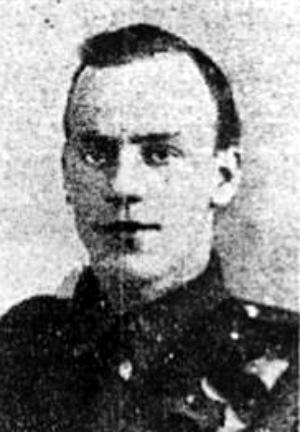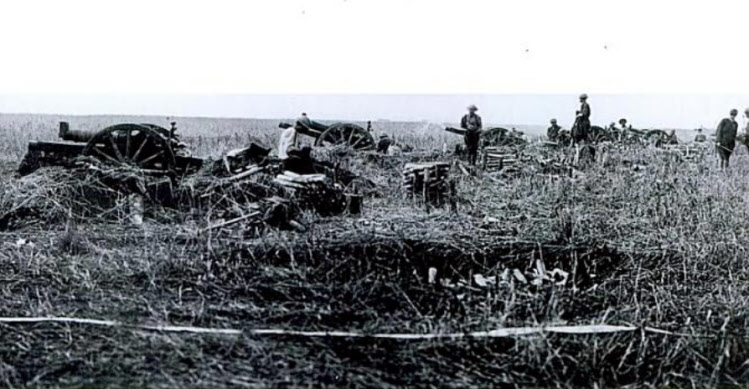
George Hargreaves was born in Ossett in 1898, the son of Middlestown coal miner Wyndham Hargreaves and his Overton born wife Esther (nee Rushforth) who married in late 1890. George was the second son of six children born to the couple in Middlestown, Ossett and Horbury.
By 1900, the family had moved to Spring End in Horbury, having lived in Ossett since 1893/94. They had remained at their four-roomed home at Spring End in 1911, by which time the couple had 10 children from their marriage. Unusually, all the children, ranging in age from one to 19 years, had survived and were living with their parents. George was the fifth child, aged 14, and still at school.
George’s army service record has not survived, but he enlisted at Horbury and joined the Royal Horse Artillery and Royal Field Artillery with regimental service number 240816. Whilst in action with ‘B’ Battery, 83rd Brigade of the Royal Field Artillery, Gunner George Hargreaves died of his wounds from being gassed in hospital at Le Treport on the 13th August 1918. He was posthumously awarded the British and Victory Medals, but not the 1914/15 Star medal indicating that he did not serve overseas before 31st December 1915.
Royal Field Artillery 83 Brigade was originally comprised of numbers 259, 260 and 261 Batteries RFA and the Brigade Ammunition Column. It was placed under command of the 18th (Eastern) Division. The brigade then remained with the division throughout WW1. ‘A’, ‘B’ and ‘C’ Batteries of the 83rd Brigade of the Royal Field Artillery were each equipped with six 18 Pound Guns plus ‘D’ Battery was equipped with six 4.5″ Howitzers.
Gunner George Hargreaves was gassed during the Battle of Amiens, which raged between the 8th and 11th August 1918. He was taken to a Field Hospital at Le Treport where he died on the 13th August from the effects of the gas poisoning. The Battle of Amiens (also known as the Third Battle of Picardy, which began on 8 August 1918, was the opening phase of the Allied offensive later known as the Hundred Days Offensive that ultimately led to the end of the First World War. Allied forces advanced over 11 kilometres (7 mi) on the first day, one of the greatest advances of the war, with Henry Rawlinson’s British Fourth Army playing the decisive role. The battle is also notable for its effects on both sides’ morale and the large number of surrendering German forces. This led Erich Ludendorff to describe the first day of the battle as “the black day of the German Army”.
George’s father, Wyndham Hargeaves, died in Spring 1915, aged 52 and after George’s death his mother’s address was given as 30, Spring End, Horbury. George Hargreaves is not remembered on any Ossett Memorial or Roll of Honour perhaps because the family lived in Horbury from around 1900, having lived in Ossett for six or seven years in the 1890s.
He is remembered in this 2014 biography and Roll of Honour because the Commonwealth War Graves Commission and/or the “U.K. Soldiers who Died in the Great War 1914-1918” listing records him as born or residing in Ossett.

Above: A Royal Field Artillery Battery in action with 18lb guns. Gunner George Hargreaves would have been part of this kind of group during the battle of Albert.
Gunner George Hargreaves, son of Mrs. E. Hargreaves, of 30, Spring End, Horbury, died in hospital from the effects wounding by of gas, aged 23 years on the 13th August 1918. He is buried at grave reference V. N. 11B at the Mont Huon Military Cemetery, Le Treport,1 Seine-Maritime, France. Le Treport is a small seaport 25 kilometres north-east of Dieppe. The Cemetery is 1.5 kilometres south of the town. Go towards the centre of Le Treport and then follow the Littoral/Dieppe sign. The Cemetery stands on the D940.
During the First World War, Le Treport was an important hospital centre and by July 1916, the town contained three general hospitals (the 3rd, 16th and 2nd Canadian), No.3 Convalescent Depot and Lady Murray’s B.R.C.S. Hospital. The 7th Canadian, 47th and 16th USA General Hospitals arrived later, but all of the hospitals had closed by March 1919.
As the original military cemetery at Le Treport filled, it became necessary to use the new site at Mont Huon. There are now 2,128 Commonwealth burials of the First World War in the cemetery and seven from the Second World War. The cemetery also contains more than 200 German war graves.
References: